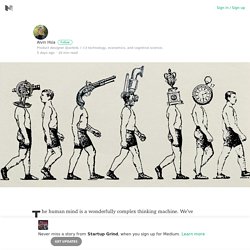

How to build a metaphor to change people’s minds. If you could ask Dante where he got the idea of life as a road, or Rilke where he found the notion that time is a destroyer, they might have said the metaphors were hewn from their minds, or drawn from a stock of poetic imagery.

Their readers might have said the imagery had origins more divine, perhaps even diabolical. But neither poets nor readers would have said the metaphors were designed. That is, the metaphors didn’t target people’s cognitive processes. They weren’t engineered to affect us in a specific way. Can metaphors be designed? Masters of Love. Gottman wanted to know more about how the masters created that culture of love and intimacy, and how the disasters squashed it.

In a follow-up study in 1990, he designed a lab on the University of Washington campus to look like a beautiful bed-and-breakfast retreat. He invited 130 newlywed couples to spend the day at this retreat and watched them as they did what couples normally do on vacation: cook, clean, listen to music, eat, chat, and hang out. And Gottman made a crucial discovery in this study—one that gets at the heart of why some relationships thrive while others languish.
Throughout the day, partners would make requests for connection, what Gottman calls “bids.” For example, say that the husband is a bird enthusiast and notices a goldfinch fly across the yard. The wife now has a choice. People who turned toward their partners in the study responded by engaging the bidder, showing interest and support in the bid. The Irrational User – Startup Grind – Medium. The human mind is a wonderfully complex thinking machine.

We’ve developed written language, built skyscrapers, and discovered quantum physics through our collective ability to plan and reason. But despite our intellect and like all earthly creatures, the mental circuitry of our biological ancestors had been optimized by evolution for a world where timeliness was more valuable than accuracy. Optimizations often present tradeoffs. In many modern decision-making contexts, humans are predictably irrational. Many studies have empirically demonstrated these types of systematic deviations, which are also known as cognitive biases or mental fallacies. The next two sections provide some background on cognitive biases. Some background Intellectual movements that led to the Enlightenment fetishized the human mind as a perfectly rational entity, capable of reasoning the very existence of God himself. The love of a parasite is worth nothing. In May of 1948, author Ayn Rand received a letter from a fan named Joanne Rondeau.

In it, she asked Rand to explain a sentence in her bestselling 1943 novel, The Fountainhead, which reads: To say 'I love you' one must first know how to say the 'I'. Rand responded with the following letter. (Source: Little Big Book Of Life; Image: Ayn Rand, via.) May 22, 1948Dear Ms. Native Intelligence. On March 22, 1621, a Native American delegation walked through what is now southern New England to meet with a group of foreigners who had taken over a recently deserted Indian settlement.

At the head of the party was an uneasy triumvirate: Massasoit, the sachem (political-military leader) of the Wampanoag confederation, a loose coalition of several dozen villages that controlled most of southeastern Massachusetts; Samoset, sachem of an allied group to the north; and Tisquantum, a distrusted captive, whom Massasoit had brought along only reluctantly as an interpreter. Massasoit was an adroit politician, but the dilemma he faced would have tested Machiavelli.
About five years before, most of his subjects had fallen before a terrible calamity. Whole villages had been depopulated. It was all Massasoit could do to hold together the remnants of his people. Europeans had been visiting New England for at least a century. How the 24-hour society is stealing time from the night.
Burmese monks know that it is time to get up when it is light enough to see the veins in their hands.

Muslims base their getting up on the passage in the Quran that defines daybreak as the time when it is possible to distinguish between a dark and a light thread. In parts of Madagascar, questions about how long something takes might receive the answer ‘the time of rice-cooking’ (about half an hour) or ‘the frying of a locust’ (a quick moment). In a world without clocks, it is natural cues or events that give some sense of time. Each day sees the sun and moon rise and set. The tides rise and fall. This organic relationship to time goes hand in hand with a far more relaxed approach to punctuality and appointments. Media Expert Dan Gillmor: Why Journalists Must Be Activists. I’m glad to be here with you today in Barcelona.

This is one of my favorites cities and regions, for many reasons that go far beyond the great people and food and remarkable things to see. There’s a spirit of political and economic innovation here that inspires me—and many others around the world. It is a special honor to be at this Congress of Catalonian journalists. Journalists are among the people who inspire me the most—most of all when they’re doing their work with persistence and integrity. The Value of Grey Thinking. One of the most common questions we receive, unsurprisingly, is along the lines of What one piece of advice would you recommend to become a better thinker? The question is kind of cheating. There is, of course, no one thing, and if Farnam Street is a testament to any idea, it’s that you must pull from many disciplines to achieve overall wisdom. No truly great thinker is siloed in a small territory.
But a common experience tends to occur as you rid yourself of ideology and narrowness, as you venture deeper and deeper into unfamiliar territory; and it’s worth thinking about it ahead of time. It goes by many names, but a fair one might be Grey Thinking. The Black-and-White Swan Children love torturing their parents and teachers with the relentless Why? Leisure, the Basis of Culture: An Obscure German Philosopher’s Timely 1948 Manifesto for Reclaiming Our Human Dignity in a Culture of Workaholism.